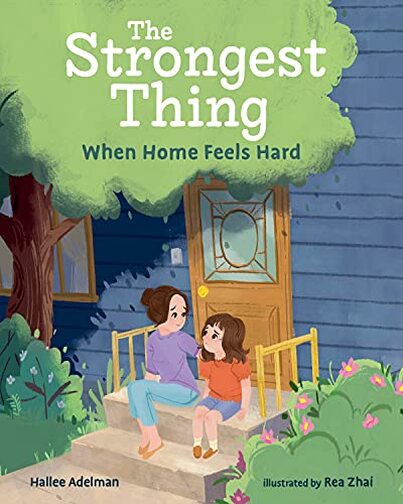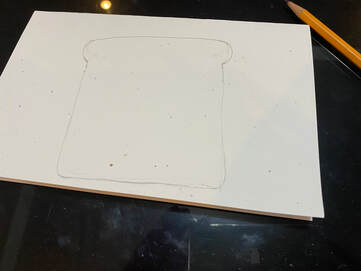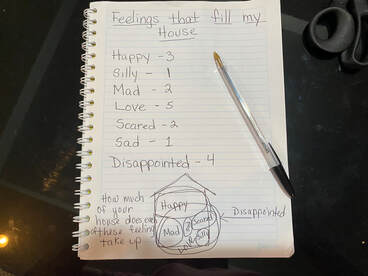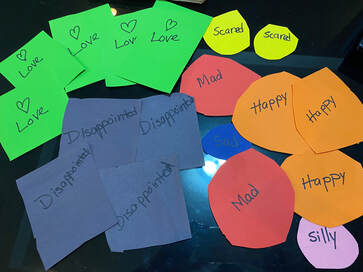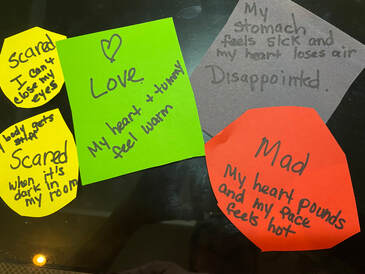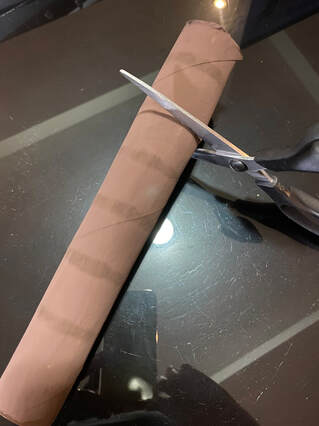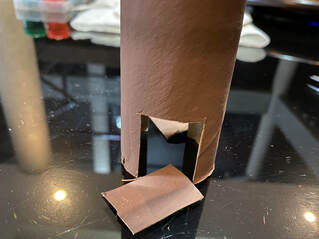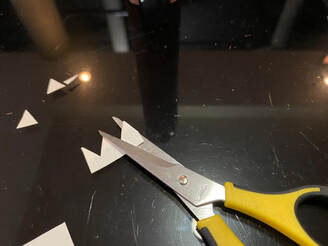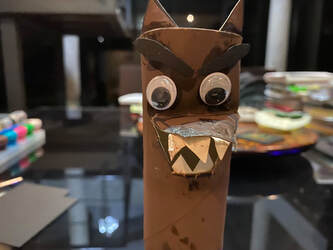A Book Review of The Strongest Thing
The book features a young girl, Sera, who finds her home a hard place to be due to her Dad's problems with anger control. He raises his voice and blames his family for things in which they have no control. At the height of his anger, he leaves the house and slams the door so hard, that the glass breaks. This is scary for Sera and creates anxiety as she anticipates what will happen when he returns. Sera thinks of her dad as "the strongest thing," because his anger seems so big, it fills up the house. So big, in fact, that, "...my house looked too small for me to fit back inside it." However, in contrast when approaching her school, Sera describes it as, " ...a shining castle on the hill, big and bright and cheery." The contrast in her description between her house and her school, shows us that Sera experiences her school as a haven. The familiar people and routines are comforting to her, and elevate her mood. The school day distracts her from thinking about the scary things at home. However, when the teacher announces that the school day is half over, Sera's mood takes a nose dive. She becomes angry and those sensations in her body, that she experienced during the incident with her father, return. "My shoulders sank like a ship, and my belly squirmed with worry." Ms. Adelman not only focuses on Sera's feelings, but the specifics of how that feeling affects her body. These sensations are described using similes which provides a clear mental picture for the reader to fully understand what Sera is experiencing. In order to name and recognize our feelings, we need to develop the skill of tuning into our bodies. This allows us to recognize those feelings through the sensations we're experiencing. After stomping around with her anger, Sera seemed to be calming herself by painting. A classmate then accidentally slams the door and startles her. It reminds her of the door slam and broken glass at home. When this happens, her painting gets ruined and she begins to act "like the bully at home," -blaming, yelling, pointing, seething. Her feelings were so big, that she felt like "the strongest thing." After observing her classmate's emotional reaction to her behavior, she knew exactly how he felt. At that point, Sera realizes that BIG ANGER was NOT the strongest thing. She then apologized, wishing her Dad would do the same for her. After the incident, she feared the worst from the teacher. However, he responded with kindness and support, which is an excellent model for teachers reading this book. His reaction also served as a model for the students, as they then offered support too. Due to the other's reactions, Sera learned that "the strongest thing" is actually being calm and kind. The last page of the book leaves the reader with a powerful message. The teacher and the mother are together in the classroom offering support to Sera. The teacher approached this situation as a team player with the parent. He did NOT call or send a note home about Sera's poor behavior. He solicited the parent to come in and assist him in supporting Sera. Care and compassion in place of punishment. Beautiful. A great message for teachers, parents and kids. There are so many important mental health messages portrayed in this book. However, I'm going to zoom in on the importance of emotional regulation in children AND adults. Adults who cannot regulate their feelings, especially their anger, create cycles of trauma in families. One of the most important things to begin learning as a child and throughout one's life is to regulate your emotions. If this skill is not mastered by adulthood, it will negatively affect a person's relationships, family, jobs, and overall happiness. Then, without the proper modeling and teaching, the cycle continues with their children. This is the reason why it is crucial to teach our kids about the different emotions, how they feel in their bodies, what makes them feel that way, and what coping skills work for them. Kids need to be allowed to express their feelings openly when younger, so when they are adults, they will have had much experience at managing them. By doing this, the trauma will not pass on to another generation. Both men and women can have problems with emotional regulation, however, anger control issues are more prevalent in boys and men. The reason for this is that traditionally, anger has been the only emotion that boys have been allowed to express. It is the emotion that is considered more "manly." Even now in 2022, some boys are still getting the message, "big boys don't cry," or "you're acting like a girl," when expressing any emotion besides anger. By keeping all of the feelings besides anger inside - sadness, hurt, disappointment, fear, etc.- those feelings get wrapped up in one big package called ANGER and that anger grows exponentially inside them. For this reason, we need to teach our boys about ALL OF THE FEELINGS. and ALLOW, AND EVEN ENCOURAGE THEM, TO EXPRESS THEM OPENLY. By doing this, they can practice coping and regulating, so by the time they are adults, they will be experienced emotional regulators. Then, and only then, will they grow up to be men who don't continue the cycle of anger and perpetuate trauma in their families. Instead, they will act as models for their children for dealing with emotions appropriately. That is the cycle we want to perpetuate. If, as a society, we understand that expressing and understanding all of the feelings makes us stronger, not weaker, the more homes like Seras' will have plenty of room for love and happiness. If you wish to purchase this book, or check out the many other mental health books written by this author, visit Hallee Adelman's website HERE. An Activity Idea for The Strongest Thing MY HOUSE IS LIKE A SANDWICH Sera describes her house "like the middle of an old sandwich, squished and dark and icky." For this month's activity, we're going to use this simile, make a sandwich and have the child fill it with the feelings in their house. NOW, LET'S BUILD OUR OWN SANDWICH! Materials: -White or beige cardstock or construction paper -Construction paper in many colors -pencil -scissors -brown and black markers
6 Comments
A Book Review of The Big, Bad Wolf In My House
Children in Domestic Violence environments, even if they are "sleeping" during the incidents, are very aware of what is going on in their home. Kids hear and notice things much more than we give them credit for. This is the reason I love that this story is told from the point of view of a child. This quote from the book, shows how insightful and observant children can be in these situations. "He batted his eyelashes and purred like a pussycat in front of my mother. But he looked at me with cold eyes and sharp teeth." Children are often the indirect victims of domestic violence. Living in a toxic, DV environment severely impacts children. This is true even if the children are not the direct victims. Kids who witness violence in their home often live "on guard," worrying about when the next incident will occur. They worry about their own safety, as well as that of the parent victim. This can lead to chronic anxiety. Kids within a DV situation also present with other symptoms which may include nightmares, sleep problems, anger, irritability, concentration issues and somatic complaints. Preschoolers may revert to younger behaviors such as bedwetting, thumb sucking, whining, etc. These issues often continue even after the child is removed from the situation. These indirect victims are also at risk for long-term consequences such as Post Traumatic Stress Disorder, Depression, health problems and repeating abusive patterns in their future relationships. The combination of powerfully written and drawn images pull the reader into the heartache of the story. For example, "The honeymoon was sour, like lemons" and "The wolf was spitting mad," provide strong images, even without the illustrations. However, the artist, Nathalie Dion, takes those written images further by shining a light on the intense feelings that the situation evokes. Speaking of shining a light, the illustrator includes literal lights illuminating certain toxic situations in the book. I find this quite clever as DV situations are often kept in the dark and remain a family secret. This book shines a light on the issue of domestic violence and shows kids that they don't have to stay in the dark with this secret. Equally as brilliant, the illustrator subtly includes shadows which provide a strong representation of the realities of this situation. The shadows of the wolf are large and elongated showing the overpowering nature of the abuser in her life and how truly scary this is for her. The last page shows a reflection of the window with crossbars over the sleeping girl in the shelter which reflects that she is now safe. The Big, Bad Wolf in My House portrays many common reactions to DV in the home by children. Some of these include over-compliance to avoid making waves, intense fear and closing off from others in order to survive mentally. The book ends on a hopeful note as the mother and daughter leave and go to a domestic abuse shelter, where the main character begins to feel safe. I highly recommend this book for kids who have been or currently are an indirect or direct victim of DV. This is an excellent resource to open up the topic of domestic violence in a gentle, yet powerful way. Children in DV situations will definitely identify with and feel less alone after reading this book. I have provided an activity below to accompany the book for the purpose of taking the discussion to the next level. If you wish to purchase the book, you can buy it HERE, or preferably, at an independent bookstore near you! An Activity Idea For The Big, Bad Wolf In My House*Discussion question ideas are below. Materials needed: -Empty cardboard paper towel roll -Brown paint -Paint brush -Googly eyes -Black and white construction paper or cardstock -Scissors -Glue
|
Follow me on Twitter, Pinterest and LinkedIn
Categories
All
|
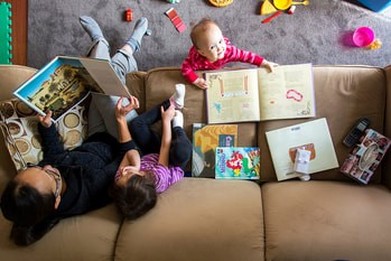
 RSS Feed
RSS Feed
